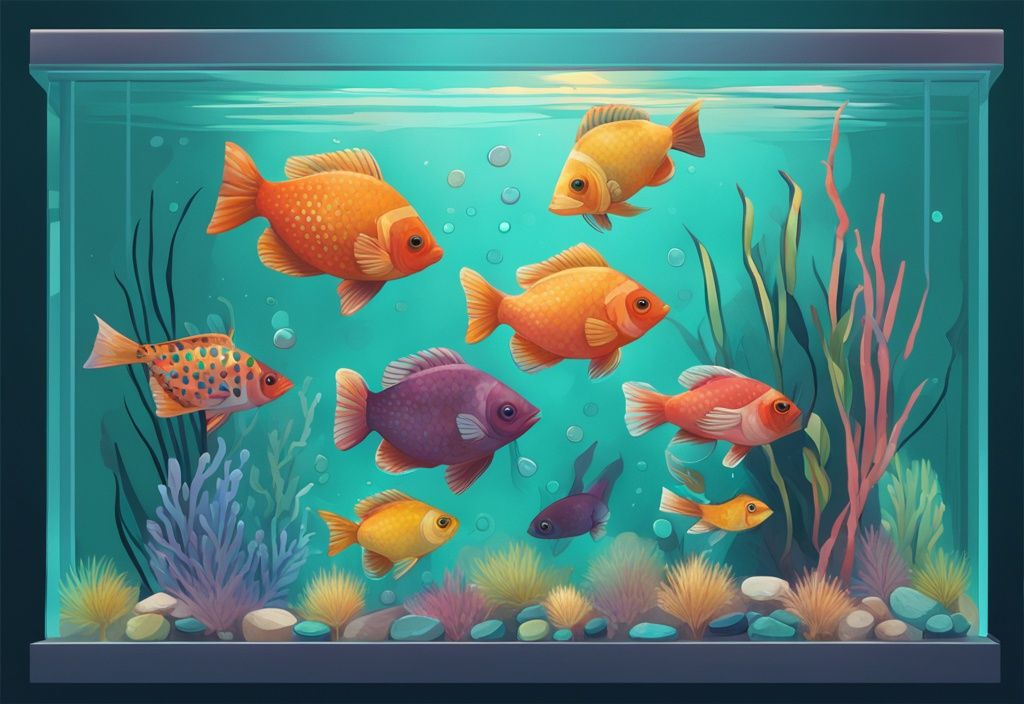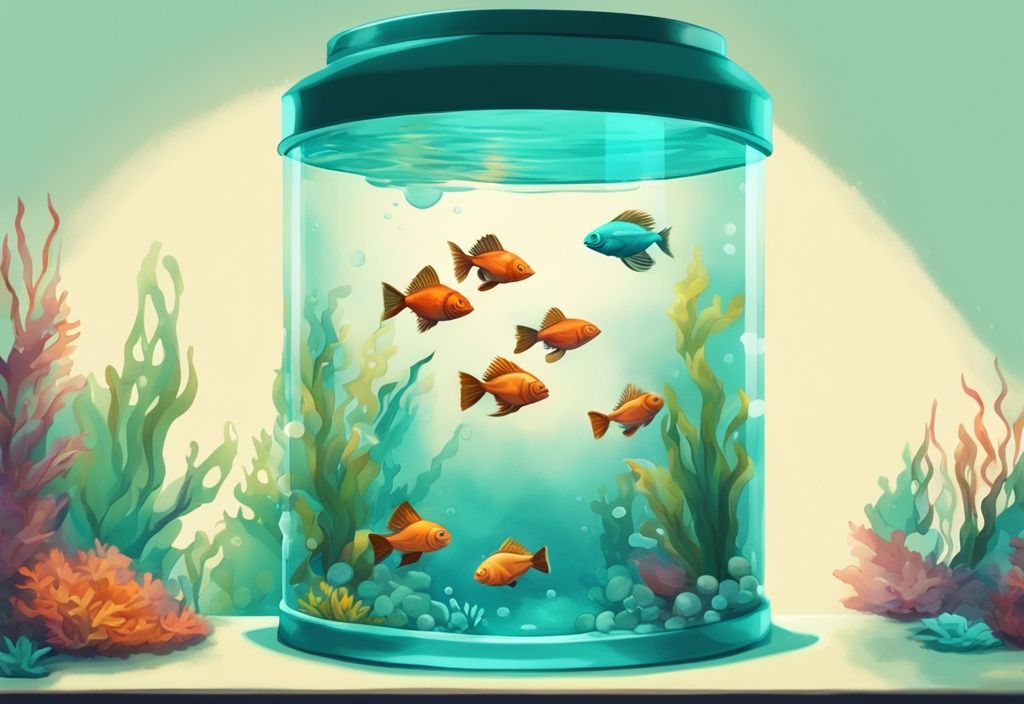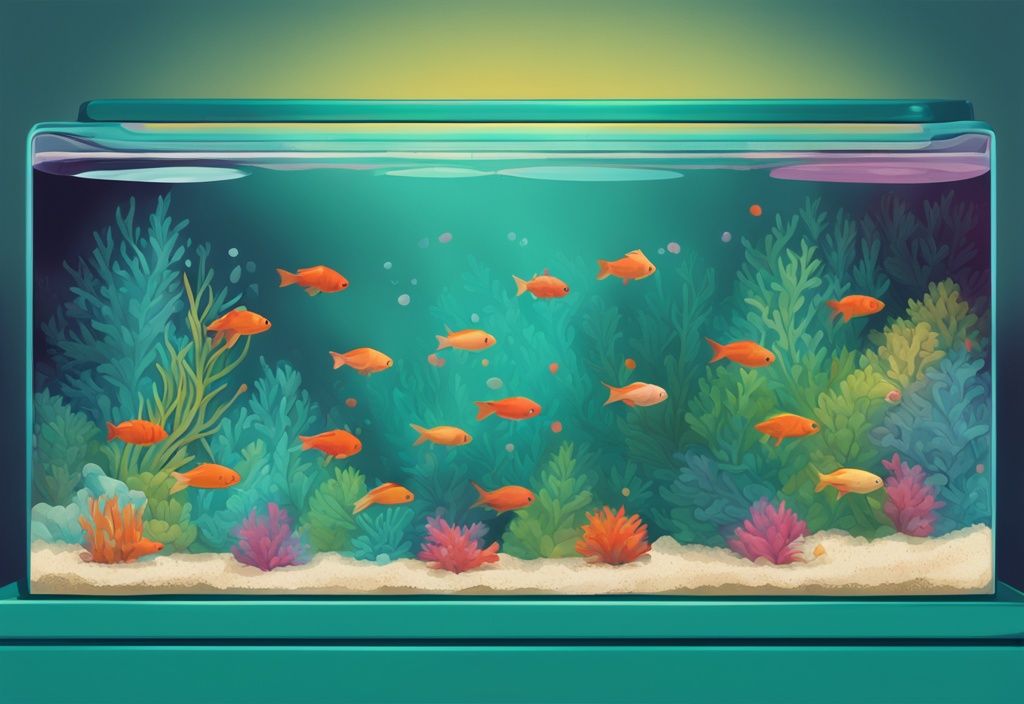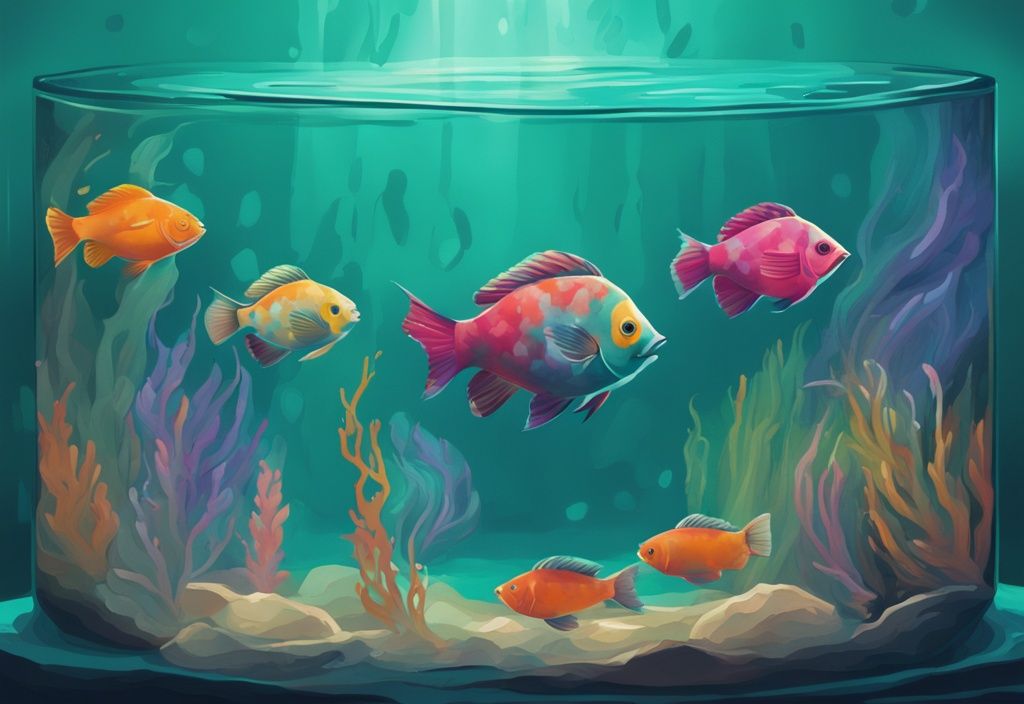Ever wondered how many fish can live harmoniously in a 5-gallon tank? As a seasoned marine biologist, I’ve spent over two decades perfecting the art of maintaining thriving aquatic ecosystems in constricted spaces. Overcrowding can cause a plethora of problems, including stress, disease, and poor water quality – all of which affect the vitality of your aquatic friends.
Understanding the balance between space and species is crucial to tank management. This guide, embedded with my years of experience, provides you with informed, actionable advice on how many fish should comfortably reside in your 5-gallon tank. Expect insights on adequate fish capacity, species compatibility, and essential maintenance tips.
Just remember: a little care and knowledge can transform even the smallest tank into a dynamic underwater paradise. Let’s dive in!
Understanding Fish Capacity in a 5-Gallon Tank
Managing a small 5-gallon tank requires careful planning to ensure a healthy aquatic environment for your fish. Let’s delve into the key factors that determine how many fish you can keep in your 5-gallon setup.
Stocking Rule: One Inch of Fish per Gallon
A time-tested guideline for determining how many fish can thrive in a 5-gallon tank is to follow the “one inch of fish per gallon” rule. This approach helps maintain a balanced ecosystem, preventing overcrowding and ensuring a healthy environment for your aquatic friends.
In practical terms, this rule means you can comfortably house about 2-5 small fish in a 5-gallon tank. However, it’s vital to ensure that each fish does not exceed 1-2 inches in size. Balance is key; overcrowding can lead to stress, increased disease risks, and deteriorated water quality.
Fish Size and Growth: What You Need to Know
When determining how many fish in a 5-gallon tank, consider the potential growth of the fish species. Keeping large-growing species, like goldfish, in a small tank isn’t advisable due to their substantial waste production and space needs.
Researching the adult size of any fish before making a purchase is fundamental. Some species might start small but grow significantly over time, outgrowing the confines of a 5-gallon tank. Opt for fish that remain within the 1-2 inch size range as adults to maintain a balanced and healthy tank environment.
Fish Compatibility: How Many Fish Can Live Together in a 5-Gallon Tank?
Understanding fish compatibility is crucial for determining how many fish can coexist in a 5-gallon tank. Compatibility ensures a peaceful environment, preventing conflicts and stress among the inhabitants.
Certain fish, like male Bettas, exhibit territorial behavior and aggression towards others, making them unsuitable for shared tanks. Regular observation of fish interactions can help in maintaining harmony within the tank. Non-territorial and peaceful species are generally better suited for cohabitation in a small tank, providing each fish ample space to establish its territory without causing disruptions.

Considering these factors, such as the one-inch-per-gallon rule, potential fish growth, and compatibility, helps in creating a balanced and thriving environment in your 5-gallon tank.
Which Fish Species are Suitable for a 5-Gallon Tank?
When contemplating how many fish in a 5-gallon tank, it’s crucial to select species that will thrive in this confined space. This section explores various fish species, their compatibility, and how to maintain a balanced aquatic environment.
Betta Fish: Can They Live in a 5-Gallon Tank?
Betta fish, celebrated for their vibrant colors and flowing fins, are a popular choice for small tanks. A 5-gallon tank can comfortably house one Betta, male or female. This tank size offers enough space for the Betta to swim and explore without feeling cramped.
It’s essential to avoid keeping multiple Bettas in a 5-gallon tank due to their territorial nature, which can lead to aggression and stress. Male Bettas, in particular, are known to be highly aggressive towards other males and sometimes even females. Thus, a single Betta in a 5-gallon setup ensures they have a peaceful environment, minimizing stress and promoting better health.
Guppies, Neon Tetras, and More: Which Tiny Fish Thrive in Small Tanks?
When considering how many fish in a 5-gallon tank, it’s important to focus on small species with low bioloads that are peaceful and comfortable in confined spaces.
Guppies are an excellent choice, with their vibrant colors and lively personalities. A small group of 3-4 guppies can thrive in a 5-gallon tank.
Neon Tetras, with their shimmering blue and red stripes, are another suitable option. A group of 4-5 Neon Tetras can be quite striking and compatible in such a setup.
Additionally, species like Mollies, White Cloud Mountain Minnows, Honey Gouramis, Least Killifish, and Celestial Pearl Danios are well-suited for a 5-gallon tank. These fish stay small and have calm temperaments, making them ideal inhabitants for a compact aquarium.
A particularly charming choice is the Ember Tetra; a small school of 5-6 can coexist peacefully in a 5-gallon tank, creating a lively and visually appealing display. These species typically have low bioloads, meaning they don’t produce excessive waste, which helps maintain good water quality in smaller tanks.
In conclusion, carefully selecting and combining small, peaceful fish species while adhering to the guidelines related to their size and compatibility allows you to create a thriving aquatic environment in your 5-gallon tank.
Special Considerations for Stocking a 5-Gallon Tank
Stocking a 5-gallon aquarium requires careful planning to ensure a balanced and healthy environment for the aquatic inhabitants. Here’s a closer look at some suitable options for this size of the tank.

Dwarf Pea Puffers: A Good Fit for Small Tanks?
Dwarf Pea Puffers are an intriguing choice for a 5-gallon tank, but it’s essential to limit the tank to a single puffer. Despite their small size, these fish can be quite territorial and need adequate space to establish their own area.
Creating a well-maintained environment with plenty of hiding spots is crucial for their well-being. Decorations such as plants and caves not only enrich their habitat but also help minimize territorial disputes.
Remember, the key to a healthy Dwarf Pea Puffer is a clean, stable aquatic environment, free from overcrowding.
Rocket Clown Killifish and The Need for a Tight-Fitting Lid
Rocket Clown Killifish can bring a lively and dynamic aesthetic to a 5-gallon tank. A small group of these fish can coexist peacefully, but it’s crucial to have a tight-fitting lid on the tank.
Known for their jumping tendencies, Rocket Clown Killifish can easily leap out, risking their safety. Monitoring their behavior and ensuring the tank is secure will prevent escapes.
These fish require a gentle water flow and plenty of surface vegetation to mimic their natural habitat, contributing to their overall health and happiness.
Considering Shrimps for Your 5-Gallon Tank: Neocaridina vs Caridina
Shrimps such as Neocaridina and Caridina are excellent additions to a 5-gallon tank, offering low bioloads and helping to keep the aquarium clean. Neocaridina varieties, like Cherry Shrimp, are generally hardier and easier to care for compared to their Caridina counterparts, making them a great choice for beginners.
Both types of shrimp graze on algae and leftover food, promoting a cleaner tank environment. While Caridina shrimp, like Crystal Red Shrimp, may require more specific water conditions, Neocaridina shrimp are quite adaptable, thriving in a range of water parameters.
This makes the latter a practical option for maintaining a balanced, vibrant 5-gallon tank.
Essential Care Tips for Your Fish in a 5-Gallon Tank
Importance of Regular Cleaning and Water Changes
In a small 5-gallon tank, the limited volume of water means that your aquatic environment is more prone to rapid changes in water chemistry. Consistent and thorough cleaning becomes paramount. Vacuuming the substrate is crucial to remove debris and uneaten food, which can degrade over time and affect water quality. Additionally, performing a 20-30% water change on a weekly basis ensures that your fish have a fresh and clean habitat. This routine helps to eliminate harmful toxins, refresh the water, and maintain a stable environment. This stability is crucial for the well-being of your fish, preventing stress and promoting health.
Maintaining Ideal Water Chemistry and Temperature
For the optimal well-being of your fish, maintaining stable water parameters in a 5-gallon tank is essential. Sudden fluctuations can cause significant stress or be fatal. A reliable filtration system is necessary to remove toxins and maintain clear water. If you’re keeping tropical fish, installing a heater to maintain stable temperatures within the range of 76-82°F is crucial. Regularly testing water parameters, including pH, ammonia, nitrites, and nitrates, ensures a balanced and optimal environment for your fish. Stability in these factors not only keeps your fish healthy but also reduces the risk of disease outbreaks, making your aquarium a safe haven.
Avoiding Overcrowding to Prevent Ammonia Build-up
Deciding how many fish in a 5-gallon tank requires careful consideration of space and the risk of overcrowding. Overstocking can result in an excessive build-up of ammonia from fish waste, which can be detrimental to your fish. Each fish needs adequate space to swim and thrive. While proper filtration and regular maintenance are essential, they cannot replace the need for sufficient space. Maintaining an appropriate number of fish helps ensure that oxygen levels remain adequate and the tank does not become a stressful environment. Following the general stocking rule of one inch of fish per gallon can help prevent these issues and promote a healthy, balanced ecosystem.

Conclusion
A 5-gallon tank can be an excellent habitat for small, carefully selected fish species when managed correctly. By adhering to stocking rules, comprehending fish compatibility, and providing the necessary care, your 5-gallon tank can flourish, ensuring the health and well-being of its inhabitants.
Stocking Rules and Fish Count: One fundamental guideline in determining how many fish in a 5-gallon tank is the “one inch of fish per gallon” rule. This generally means that in such a small tank, you’re looking at keeping between 2 to 5 small fish, each measuring no more than 1-2 inches at maturity.
Proper stocking helps to prevent overcrowding, which can lead to stress, disease, and compromised water quality.
Understanding Fish Compatibility: Selecting the right combination of fish species is vital. Some fish are more territorial than others, while some are more sociable. For example, Betta fish are known for their aggressive nature towards each other, making it crucial to avoid housing multiple Bettas in a single 5-gallon tank. In contrast, small, peaceful species such as Guppies, Neon Tetras, or Ember Tetras are more suitable due to their manageable size and lower bioloads. Additionally, incorporating house plants in the aquarium can enhance the environment by providing natural filtration and shelter.
Fish Care and Tank Maintenance: Maintaining a healthy aquatic environment in a 5-gallon tank requires more frequent attention due to the small water volume, which is prone to rapid changes in water chemistry. For more insights on maintaining proper water parameters and ensuring a thriving aquarium, check out this resource on maintaining proper water parameters. Regular cleaning and water changes, typically 20-30% weekly, along with vigilant monitoring of water parameters like pH, ammonia, nitrites, and nitrates, are fundamental practices to keep the tank stable. Proper filtration and, if necessary, a heater for tropical species, will further ensure a thriving habitat. If you notice white spots on your fish tank glass, it may indicate an imbalance or the need for additional maintenance.
In conclusion, the key to successfully keeping fish in a 5-gallon tank lies in careful planning and diligent care. Thoroughly research the specific needs and behaviors of the fish species you intend to keep, and always aim for a balanced and harmonious aquatic ecosystem to enjoy a vibrant and engaging fish-keeping experience.
Common Questions About How Many Fish in a 5-Gallon Tank
Can I Keep Multiple Bettas in a 5-Gallon Tank?
No, keeping multiple Bettas in a 5-gallon tank can lead to aggression and stress. Bettas are territorial and very aggressive toward each other, especially males. Therefore, it’s recommended to keep only one Betta in a 5-gallon tank to ensure its well-being and proper space.
Is a Heater Necessary for a 5-Gallon Tank?
Yes, a heater is necessary for a 5-gallon tank, especially if you are keeping tropical fish like Bettas. These species thrive in water temperatures between 76-82°F. A stable, warm temperature is crucial for their health and well-being. It helps prevent stress and potential diseases caused by fluctuating temperatures.
What’s the Best Filtration System for a 5-Gallon Tank?
A small, efficient filter that offers both mechanical and biological filtration is ideal for a 5-gallon tank. Sponge filters or small internal filters are often recommended. They help maintain water clarity by removing toxins and support beneficial bacteria that are essential for a healthy ecosystem.
How Often Should I Clean My 5-Gallon Tank?
Perform a 20-30% water change weekly to maintain water quality. Regular substrate vacuuming removes debris and waste. Cleaning filter media monthly ensures it functions efficiently. Avoid over-cleaning, which can disrupt beneficial bacteria that are crucial for biological filtration.
